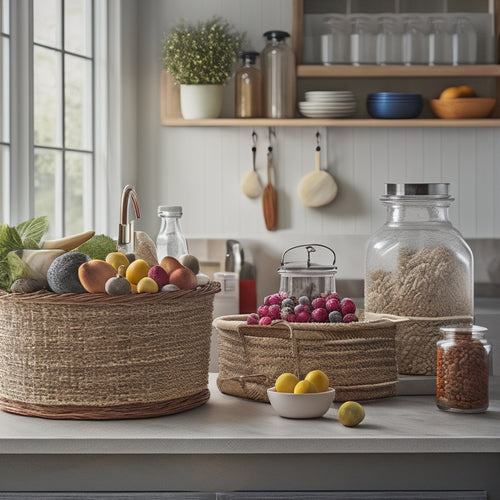
UVM Extension: Revolutionizing Agriculture Storage Practices
Share
The University of Vermont (UVM) Extension is revolutionizing agriculture storage practices by addressing post-harvest food storage challenges. Minimizing losses, reducing energy consumption, and maintaining product quality are key priorities. Research emphasizes the importance of implementing energy-saving strategies and technologies, adopting sustainable post-harvest techniques, and optimizing storage conditions. The adoption of advanced climate control systems, cutting-edge refrigeration technologies, and integrated renewable energy systems is essential for ensuring the safety and quality of stored produce. As the agricultural industry continues to evolve, innovative solutions are emerging to transform the future of food storage - and there's more to discover.
Key Takeaways
• Minimizing post-harvest losses is crucial to ensure food security and reduce environmental impact, with 66% of respondents planning to expand storage capacity.
• Implementing sustainable post-harvest techniques and energy-saving strategies is vital to reduce the environmental footprint of food storage.
• Advanced climate control systems and cutting-edge refrigeration technologies are emerging to optimize storage conditions and ensure produce safety and quality.
• Energy-efficient refrigeration systems and integrated renewable energy solutions can significantly reduce energy consumption and costs for storage facilities.
• Farmers can optimize storage conditions with innovations, adopting best practices and technology to maintain product quality and reduce waste.
Enhancing Food Storage Efficiency
Enhancing food storage efficiency is essential for minimizing post-harvest losses, reducing energy consumption, and maintaining product quality, as shown by the 66% of respondents planning to expand their food storage capacity in the next 24 months.
Implementing energy-saving strategies and technology can greatly reduce the environmental impact of food storage. Temperature control and monitoring play a vital role in maintaining ideal storage conditions, ensuring product quality and safety. Advanced temperature monitoring systems enable real-time tracking, allowing for quick response to any temperature deviations.
Sustainable Post-Harvest Techniques
Implementing sustainable post-harvest techniques is vital for reducing the environmental impact of food storage. This is evidenced by the 60% of respondents who store in multiple zones but lack knowledge of best conditions.
To address this issue, UVM Extension emphasizes the adoption of energy-saving technologies and climate-controlled environments. These innovations enable farmers to optimize storage conditions, minimizing energy consumption and reducing the carbon footprint of their operations.
Innovative Storage Solutions Ahead
As the agricultural industry continues to evolve, innovative storage solutions are emerging to address the complex challenges of food storage, from advanced climate control systems to cutting-edge refrigeration technologies. These advancements are essential in ensuring the safety and quality of stored produce.
Some of the key innovative solutions include:
- Advanced climate control systems that maintain best temperature and humidity levels
- Energy-efficient refrigeration systems that reduce energy consumption and costs
- Automated temperature monitoring systems for real-time tracking and alerts
- Innovative insulation materials that reduce heat transfer and energy loss
- Integrated renewable energy systems that power storage facilities sustainably
These technology advancements and climate control strategies are revolutionizing agriculture storage practices, enabling farmers and producers to store their produce safely and efficiently.
Frequently Asked Questions
How Does Humidity Affect the Quality of Stored Produce?
Humidity impacts stored produce quality by influencing water loss, microbial growth, and enzymatic activity. Maintaining ideal humidity levels (typically 80-90%) is vital for quality preservation, as excessive moisture can lead to spoilage and reduced shelf life.
Can I Repurpose an Existing Structure for Food Storage?
'Like a canvas awaiting a masterpiece, an existing structure can be repurposed for food storage with strategic structural modifications and retrofitting options, considering environmental considerations and preservation techniques to guarantee a safe and ideal storage environment.'
What Are the Optimal Storage Conditions for Specific Crops?
Ideal storage conditions for specific crops require precise temperature control to maintain produce quality, while ventilation needs are critical for storage efficiency, ensuring a safe and controlled environment that prevents spoilage and preserves nutritional value.
How Do I Calculate the ROI on Investing in a New Storage System?
To calculate the ROI on investing in a new storage system, conduct an investment analysis and cost-benefit analysis, considering factors such as reduced energy consumption, extended shelf life, and increased efficiency, to determine the financial viability of the investment.
Are There Grants Available for Sustainable Food Storage Projects?
Yes, various funding opportunities exist for sustainable food storage projects, including grants from government agencies and private organizations, which support the adoption of energy-efficient technology solutions and environmentally friendly practices.
Related Posts
-

Tiered Kitchen Rack Ideas for Small Spaces
Tiered kitchen racks are perfect for maximizing small spaces while adding style and functionality. Install wall-mount...
-

Countertop Storage Ideas for Busy Homeowners
As a busy homeowner, optimizing your kitchen countertop is essential for efficiency and style. Consider using vertica...
-

Affordable Sliding Pantry Drawer Solutions
If you're looking for affordable sliding pantry drawer solutions, you're in the right place. These drawers maximize s...


